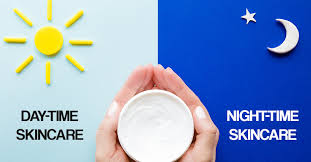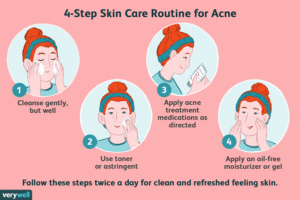When it comes to skincare, one size doesn’t fit all—especially when comparing your morning and night routines. While the basic steps might look similar, the purpose and products used in your AM vs. PM skincare can differ significantly.
So, what exactly is the difference between morning and night skincare? And why does it matter?
In this article, we’ll break down how your skin behaves at different times of the day, why certain products work better in the morning or evening, and how to build an effective routine that keeps your skin glowing 24/7.
🌞 What Your Skin Needs in the Morning
Your skin’s main job during the day is defense. It faces environmental aggressors like UV rays, pollution, dirt, and stress—all of which can lead to premature aging, dullness, and breakouts.
That’s why a morning skincare routine focuses on:
- Protection
- Hydration
- Creating a smooth base for makeup or sunscreen
✔️ Morning Skincare Goals:
- Cleanse away sweat or oil from the night
- Hydrate the skin for the day ahead
- Apply antioxidants to neutralize damage
- Shield your skin with SPF
✅ Basic Morning Skincare Routine (Step-by-Step)
- Gentle Cleanser
Cleans away nighttime sweat, oil, and residue.
Choose a non-stripping, sulfate-free formula. - Toner (Optional)
Balances pH and preps your skin for other products.
Hydrating or clarifying toners work best in the morning. - Antioxidant Serum (e.g., Vitamin C)
Fights free radicals, brightens complexion, and supports collagen production.
Vitamin C is most effective when used under sunscreen. - Moisturizer
Hydrates and smooths the skin.
Choose lightweight gels for oily skin or creams for dry skin. - Sunscreen (SPF 30 or higher)
Protects against UVA/UVB damage.
This is the most critical morning step, whether you’re indoors or outdoors.
🌙 What Your Skin Needs at Night
At night, your skin switches into repair and recovery mode. While you sleep, your skin regenerates, repairs damage from the day, and produces collagen.
A nighttime skincare routine is the perfect time to:
- Deeply nourish your skin
- Use treatment products (like retinol or exfoliants)
- Support overnight healing and cell turnover
✔️ Night Skincare Goals:
- Remove dirt, makeup, and SPF
- Restore moisture and nutrients
- Treat specific skin concerns (acne, fine lines, hyperpigmentation)
- Support skin regeneration
✅ Basic Night Skincare Routine (Step-by-Step)
- Makeup Remover or Cleansing Balm (If Needed)
Breaks down makeup, sunscreen, and excess sebum.
Use this as the first step in a double cleanse. - Face Cleanser
Removes leftover impurities and clears pores. - Exfoliant (1–2x per week)
Helps remove dead skin cells and promote radiance.
Use AHAs (like glycolic acid) or BHAs (like salicylic acid) based on your skin type. - Treatment Serum (e.g., Retinol, Niacinamide, Peptides)
Choose products based on your skin goals.
Retinol helps with aging; Niacinamide reduces pores and pigmentation. - Moisturizer or Night Cream
Locks in hydration and supports barrier repair.
Look for nourishing ingredients like ceramides or hyaluronic acid. - Facial Oil or Sleeping Mask (Optional)
Adds an extra boost of hydration, especially for dry or aging skin.
🔄 Morning vs. Night Products: What’s the Real Difference?
Let’s compare how products vary depending on the time of day:
| Product Type | Morning Use | Night Use |
|---|---|---|
| Cleanser | Light, gentle | Deeper, double-cleanse if makeup is worn |
| Serum | Antioxidants (Vitamin C, Niacinamide) | Treatment-focused (Retinol, Acids, Peptides) |
| Moisturizer | Lightweight, non-greasy | Rich, nourishing, barrier-repairing |
| Sunscreen | Essential step! | Not needed |
| Exfoliants | Usually skipped | Best used 1–2x a week |
| Eye Cream | Brightening or cooling | Hydrating, anti-aging ingredients |
💡 Why Time of Day Matters for Skincare
🧬 1. Your Skin Has a Biological Clock
Your skin functions differently during the day and night:
- Day: Focus is on protection from UV and environmental stress.
- Night: Skin goes into repair mode, producing collagen and regenerating cells.
🌡️ 2. Absorption Rates Are Higher at Night
At night, there’s less sebum production, your skin temperature rises slightly, and there’s no makeup or SPF barrier—so products absorb better.
🧴 3. Some Ingredients Are Sun-Sensitive
Certain actives like retinol, AHAs, and BHAs can make your skin more sensitive to sunlight and are best used at night.
⚠️ Common Mistakes to Avoid
- ❌ Using retinol in the morning – It breaks down in sunlight and may irritate the skin.
- ❌ Skipping sunscreen after Vitamin C – Vitamin C boosts your SPF’s effectiveness, but doesn’t replace it.
- ❌ Overloading your skin with actives at night – Start slow and build tolerance.
- ❌ Not cleansing properly at night – Dirt and sunscreen buildup can cause clogged pores and breakouts.
🧴 Example: Morning and Night Routine for Beginners
Morning Routine (AM):
- Gentle Cleanser
- Hydrating Toner
- Vitamin C Serum
- Lightweight Moisturizer
- Broad-spectrum Sunscreen (SPF 30 or higher)
Night Routine (PM):
- Makeup Remover (if needed)
- Cleanser
- Retinol Serum (2–3x/week) or Niacinamide
- Barrier-boosting Moisturizer
- (Optional) Facial Oil or Sleeping Mask
🌟 Final Thoughts: Consistency Over Complexity
The key to healthy skin isn’t about having a 10-step routine—it’s about understanding your skin’s needs during different times of the day and using the right products consistently.
- Use your morning routine to protect and prepare.
- Use your night routine to treat and repair.
Give your skin time, and you’ll start seeing visible improvements in texture, clarity, and glow.



